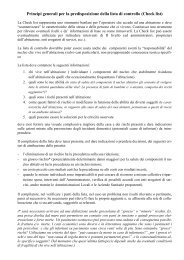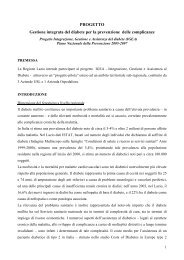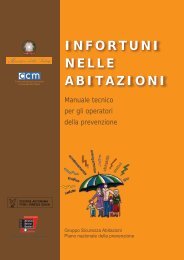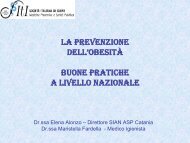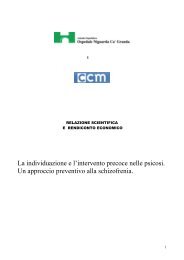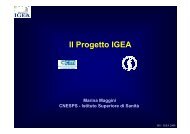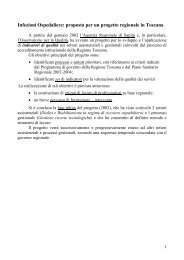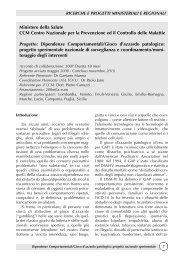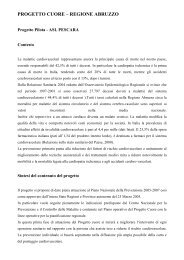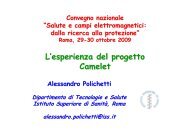Gaining health : analysis of policy development in European ...
Gaining health : analysis of policy development in European ...
Gaining health : analysis of policy development in European ...
Create successful ePaper yourself
Turn your PDF publications into a flip-book with our unique Google optimized e-Paper software.
<strong>of</strong> the HCSP. A thorough situation <strong>analysis</strong> was made and<br />
concrete, quantifiable targets were set <strong>in</strong> the report <strong>of</strong> the<br />
expert group. In the mean time, INSERM issued a scientific<br />
report on child obesity with key f<strong>in</strong>d<strong>in</strong>gs about the challenges<br />
related to nutrition <strong>in</strong> French society (18,19).<br />
Thanks to the reports <strong>of</strong> the HCSP and INSERM and the<br />
Green Paper on food safety, all published nearly at the same<br />
time, nutrition-related themes were took centre stage. In<br />
addition, <strong>in</strong> 2000, France took over the EU presidency and<br />
the M<strong>in</strong>istry <strong>of</strong> Health s<strong>in</strong>gled out nutrition as a key priority<br />
<strong>in</strong> the French work<strong>in</strong>g programme. Dur<strong>in</strong>g the presidency,<br />
national and <strong>in</strong>ternational work<strong>in</strong>g groups were established<br />
and on 13 December 2000, at the <strong>European</strong> Summit <strong>of</strong><br />
Health M<strong>in</strong>isters, nutrition was the key item on the agenda.<br />
The next day, the French Prime M<strong>in</strong>ister announced a<br />
broad debate on nutrition and asked the M<strong>in</strong>ister <strong>of</strong> Health<br />
to launch a nutrition strategy and set up an Interm<strong>in</strong>isterial<br />
Committee on Nutrition. A scientific Pilot Committee was<br />
also established, whose members were middle-level adm<strong>in</strong>istrators,<br />
practitioners and researchers. The coexistence <strong>of</strong><br />
both committees is considered to have been fruitful. The<br />
Interm<strong>in</strong>isterial Committee is a rather adm<strong>in</strong>istrative, highlevel<br />
body while the Pilot Committee carries out scientific<br />
studies, coord<strong>in</strong>ates activities, facilitates the exchange <strong>of</strong><br />
<strong>in</strong>formation and experience, and <strong>in</strong>itiates further actions.<br />
The report <strong>of</strong> the Interm<strong>in</strong>isterial Committee was issued<br />
<strong>in</strong> early 2001 as the first PNNS. In 2005, after overwhelm<strong>in</strong>g<br />
success and a positive evaluation, it was extended until<br />
2008; its cont<strong>in</strong>uity is also ensured by the Public Health Act<br />
<strong>of</strong> 2004.<br />
The name <strong>of</strong> PNNS reflects its general aim <strong>of</strong> <strong>in</strong>corporat<strong>in</strong>g<br />
and l<strong>in</strong>k<strong>in</strong>g nutrition <strong>in</strong>to the various fields <strong>of</strong> <strong>health</strong> promotion.<br />
The guid<strong>in</strong>g pr<strong>in</strong>ciples <strong>in</strong>clude a multisectoral approach<br />
with quantifiable objectives, focus<strong>in</strong>g on promotion and<br />
primary prevention while embrac<strong>in</strong>g a food culture <strong>of</strong><br />
gastronomy and eat<strong>in</strong>g together, and based on <strong>in</strong>dependent<br />
scientific <strong>analysis</strong>. PNNS <strong>in</strong>cludes n<strong>in</strong>e specific objectives on<br />
physical activity and nutrition. Strategies tackle the improvement<br />
<strong>of</strong> both supply and demand for <strong>health</strong>y food and<br />
physical activity and partnership with the stakeholders from<br />
the private sector such as producers, manufacturers, retailers<br />
and caterers (<strong>in</strong> schools and places <strong>of</strong> work). To achieve<br />
this, a multisectoral committee chaired by the M<strong>in</strong>istry <strong>of</strong><br />
Health was established <strong>in</strong> 2001, <strong>in</strong>clud<strong>in</strong>g representatives<br />
<strong>of</strong> eight m<strong>in</strong>istries, the food <strong>in</strong>dustry, consumer associations<br />
and local authorities.<br />
In 2004, a document was issued deal<strong>in</strong>g specifically with<br />
cycl<strong>in</strong>g (20). A general sports programme entitled “Move<br />
for <strong>health</strong>” was adopted <strong>in</strong> 2004 to fight sedentary lifestyles<br />
and promote physical activity and sport. The programme<br />
aims at distribut<strong>in</strong>g <strong>in</strong>formation and evaluat<strong>in</strong>g the physical<br />
condition <strong>of</strong> the population (21).<br />
In 2002, national food guidel<strong>in</strong>es were produced and<br />
later a complementary brochure was published on physical<br />
activity by the Pilot Committee and INPES. Separate<br />
guidel<strong>in</strong>es for adolescents were produced <strong>in</strong> 2004, address<strong>in</strong>g<br />
both nutrition and physical activity. In 2005, three large<br />
media campaigns were launched by INPES on fruit and<br />
vegetables, physical activity and reduc<strong>in</strong>g the consumption<br />
<strong>of</strong> sugary foods. With<strong>in</strong> the economic sector, bakers were<br />
encouraged to reduce the salt content <strong>of</strong> bread. Leaflets<br />
on <strong>health</strong>y lifestyles for different population groups were<br />
developed, as well as educational materials for teachers.<br />
In September 2005, vend<strong>in</strong>g mach<strong>in</strong>es <strong>in</strong> school campuses<br />
were banned and the quality <strong>of</strong> school meals was improved,<br />
based on specific guidel<strong>in</strong>es. Furthermore, a new <strong>policy</strong> on<br />
food and dr<strong>in</strong>k advertis<strong>in</strong>g was <strong>in</strong>troduced, requir<strong>in</strong>g that all<br />
carry <strong>health</strong>-related <strong>in</strong>formation provided by the M<strong>in</strong>istry <strong>of</strong><br />
Health. If a company does not want to <strong>in</strong>clude such <strong>in</strong>formation<br />
<strong>in</strong> its advertisements, it has to donate 1.5% <strong>of</strong> the<br />
advertis<strong>in</strong>g costs to be used for <strong>health</strong> promotion. An attempt<br />
to amend the national public <strong>health</strong> law so that food<br />
advertis<strong>in</strong>g on television would <strong>in</strong>clude this <strong>health</strong>-related<br />
Chapter 4<br />
87<br />
Case studies: <strong>policy</strong> <strong>development</strong> <strong>in</strong> countries for tackl<strong>in</strong>g noncommunicable diseases



